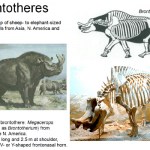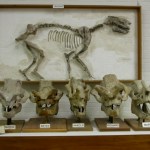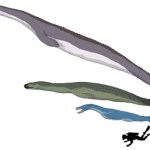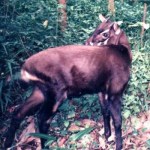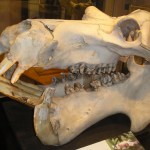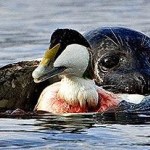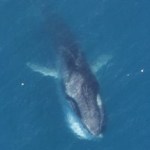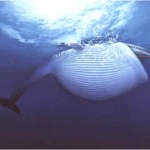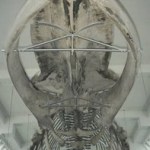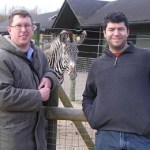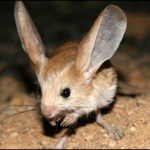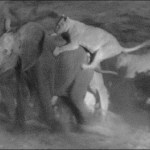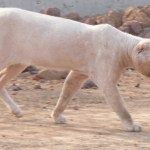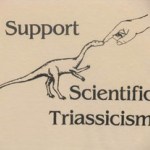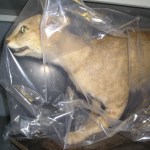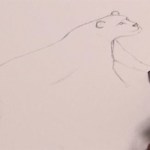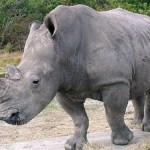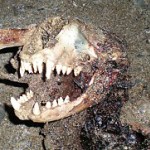mammalogy
Yesterday's brief look at brontotheres was such a rip-roaring success I thought I'd do a little bit more on them (on members of Brontotheriidae that is, not on rip-roaring successes). No time for a proper article: all I've done here is to take screen-shots of various powerpoint slides (from a perissodactyl lecture I give), and throw in a few words where appropriate.
To begin with, we mostly know of brontotheres thanks to the gigantic, Late Eocene North American taxon Megacerops Leidy, 1870, now thought to include both Brontotherium Marsh, 1873 and Brontops Marsh, 1887 (the slides shown here…
Here's a photo Matt Wedel took in the Raymond Alf Museum in Claremont, California. The lined-up skulls belong (I think) to Megacerops, the large to very large Late Eocene brontothere previously known as Brontotherium. Like most other brontotheriine brontotheres it has reduced, globular upper incisors and is very wide at the back of the skull. The upper incisors were in fact so small that they might have been virtually useless, and these animals probably relied on a prehensile lip to gather food. Must stop there - want to start talking about horns and evidence for intraspecific combat, but…
By complete coincidence - honestly! - we looked yesterday at discovery rates among terrestrial mammals. All indications are that many species remain to be discovered. It should also be well known, and I hope it is, that the same is true for large marine vertebrates: recent discoveries, and extrapolations based on discovery rates, indicate that there are still new, large marine animals to find. Today sees the publication of a new paper by myself and two colleagues, Michael Woodley and Hugh Shanahan, in which we attempt to estimate the number of pinnipeds that might remain undiscovered (…
Hopefully it is well known that we still have a lot to learn about the planet's extant macrofauna. And, by 'macrofauna', I'm not talking about nematodes, molluscs or insects but, yes, about such things as mammals. In fact, on mammals specifically, discovery rates indicate that we really should expect the discovery of new species for a long while yet. In a new article in Proceedings of the National Academy of Sciences, Ceballos & Ehrlich (2009) bring attention to the fact that 408 new mammal species (representing about 10% of the total mammal species inventory and belonging to 18…
Yeah, like it says in the title.. what is wrong wih this hippo? (photographed at Plymouth Museum and Art Gallery). Or, 'was' wrong.. given that it's now dead. I really should say more about hippos at some stage. So far there's only this, and that's just not good enough.
Like many 'generalised' carnivores, the Common or Harbour seal Phoca vitulina is a surprisingly adaptable predator, even if it is rather conservative in diet and choice of foraging habitat (e.g., Tollit et al. 1998). This photo, taken by Philip Kirkham, is part of a sequence in which a seal stalks, catches, and then dismembers and eats a duck (the duck is a Common eider Somateria mollissima). We all know that such pinnipeds as Leopard seals Hydrurga leptonyx and various sea lions and fur seals routinely catch and eat birds (Todd 1988), but it's a bit surprising to see the small, normally…
Not only am I now unable to edit my blogroll (a very minor thing, but one that bugs me nonetheless), I am also incapable of understanding how ResearchBlogging is supposed to work. I registered, but cannot get my posts to appear there, so am going to give up. Oh well, it's not like it matters I suppose (hmm, or does it?). Am currently busy with the books, and am also (with co-authors) putting the finishing touches to some very neat papers... on which all will be revealed in due time. Anyway, to business, and to the last of those rorqual articles. Please see part I and part II first. The…
More on those rorquals: part I is required reading. To those who have seen this stuff before: sorry, am going through a busy phase and no time for new material (blame dinosaurs and azhdarchoid pterosaurs... and baby girls). Oh, incidentally, I recently registered Tet Zoo with ResearchBlogging: I haven't done this before because 'blogging on peer-reviewed research' is the norm at Tet Zoo, not the exception. It seems to take ages for posts to be uploaded to ResearchBlogging - like, hours. Is this normal? Anyway...
This time we look at the basics of rorqual morphology and at their feeding…
Sorry, nothing new: time again for something from Tet Zoo ver 1...
Late in the 1920s, plans to replace the old whale hall of the British Museum (Natural History) were fulfilled. Thanks to the new, steel-girdled hall, the Blue whale skeleton - by now kept in storage for 42 years due to lack of space - could finally be put on display [adjacent image, © NHM]. This skeleton belonged to a 25 m animal that had stranded at Wexford Bay, SE Ireland, in 1891. It - as in, the skeleton alone - weighs over 10 tons. But some people at the museum wanted more, and in 1937 taxidermist Percy Stammwitz (1881-…
Dave Hone - who's had more than his fair share of mentions here at Tet Zoo over the past several days - accompanied me on a visit to Marwell Zoo yesterday. We had a great time, but unfortunately got all too little paper-writing done :) (after all, this is what scientists normally do when they meet up). There's always something new to see, or experience, at the zoo. The Frill-necked lizards Chlamydosaurus kingii were brand-new, for example: it was in fact only their second day on exhibit. And I've never heard a Snow leopard Panthera uncia roar before. It didn't sound like any other big cat…
More stuff from the archives... or, from Tet Zoo ver 1 anyway. The following article is about the bizarre jerboa Euchoreutes naso. Back when I wrote the article (2006), there were no photos of this species available, and I had to resort to using a single painting. However, a glut of good photos are now available, as explained below. Incidentally, do not ever google the term 'Asian wild life'.
-------------------------------------------------
It's funny how things work out. Today I am obsessed with rodents. Why? Most of my day was spent clearing out an old loft, and while rummaging through…
I am happy to report that, at 9-43am this morning (Saturday 7th), Mrs Toni Naish gave birth to baby Emma. Things started round about 5am and, needless to say, the entire day has been taken up with baby duties. Some of you might know that southern England has been badly affected over the past week by ice and snow: a pathetic amount, but enough to prevent the movement of traffic and bring the region to its knees. Happily, our early morning journey to the hospital was uneventful and all went well. Anyway, Emma is wonderful and perfectly formed, and so far has slept an awful lot. It's fantastic…
In 2006, the second series of the BBC's Planet Earth was screened. If you saw the series, you'll know that it included a lot of awesome stuff. One thing that got an awful lot of people talking was the amazing footage - included as part of episode 2 ('Great Plains') - showing the elephant-killing lions of Savuti in Chobe National Park, northern Botswana. I wrote about this footage at Tet Zoo ver 1 back in November 2006 (it's here), and - for those who didn't see it first time round - here it is again...
While most people 'know' that elephants are immune to predation thanks to their size,…
It's very funny how things sometimes work out. I had absolutely no plans whatsoever to cover cats at Tet Zoo this week. Then, on Friday, I watched the documentary that featured the pogeyan* and, obviously, decided that it was worth covering. And, during the County Museum visit on Saturday, my encounter with the Hayling Island Jungle cat was totally fortuitous: I'd forgotten that it was there, and probably would have missed it were it not for the fact that Chris Palmer got it out of its cabinet. Yesterday, I received some very interesting photos from Ryan Norris at the University of Vermont.…
Oh my god. Two years at ScienceBlogs have passed, and Tet Zoo has now been going for three years. It all started on January 21st 2006 when, for no good reason at all, I started a blog over at blogspot.com. Yes, Tet Zoo is three years old. Time to look back at the past year of operation.
For starters, should you want to know more about Tet Zoo's origin and history of operation, read Happy first birthday Tetrapod Zoology part I and part II (both at ver 1), and Happy second birthday part I and part II. Last year, I included a 'what happened in tetrapods during 2007'. I'm not going to do the…
Over the weekend I and a bunch of others from the Southampton Natural History Society visited the collections at the County Museum, Winchester (Hampshire, UK). This is a research collection and local repository, and is not open to the public. We saw tons of stuff and had a great time. I took Will (my 7-year-old) along, and he loved it, spending literally hours looking through drawers of pinned insects and at stuffed things in cases. I see every indication that kids are naturally fascinated by animals and other living things: it's just that this interest is often not switched on at the right…
I've pretty much given up on TV. I occasionally watch a few things (The IT Crowd, Doctor Who, QI, Never Mind the Buzzcocks), but mostly it's all shit and I'd be very happy to not have a TV at all. Once in a blue moon, however, there is something really good. On Friday evening (Jan 16th), BBC 2 screened 'The Mountains of the Monsoon' as part of its The Natural World series. This featured wildlife photographer and environmentalist Sandesh Kadur as he travelled about the Western Ghats in quest of wildlife.
The Western Ghats evidently has some awesome wildlife. There are dholes, tigers,…
Most people who know stuff about animals 'know' that the White rhino Ceratotherium simum owes its vernacular name - not to its colour - but to its wide, flattened lips. After all, the 'White' rhino is not really any whiter than any other rhino. So, the 'white' must - so everyone has been saying - be a corruption of 'wijde', the Dutch for 'wide'. That way, the rhino's name would have started out as Dutch for 'wide-lipped rhino', and that makes sense, right? As it happens, and as rhino expert Kees Rookmaaker of the IUCN's Rhino Resource Center argued in 2003, this explanation just doesn't work…
Last year the blogosphere and global media went nuts over the 'Montauk monster'. A small mammal corpse that washed up on the beach at Long Island, New York, it was not an alien, government experiment, or sea-monster, as widely claimed by idiots worldwide, but - without doubt - a dead, rotten raccoon. This month a vaguely similar sort of thing is happening, though this time there is less hype. And, for me, the corpse is closer to home, having been discovered on Croyde Beach in Devon, southern England [its skull is shown at left]. The Croyde carcass made several national newspapers, including…
It's not everyday that you discover a shop named after a group of fairly obscure amphibious lipotyphlans. While in Spain last year, I was intrigued by this shop...
I think it sold clothes or something, though frankly I don't recall checking. Here's a close-up of the animal featured on the signage...
Desmans are members of Talpidae (the same group that includes the moles), and there are only two extant species: the Russian desman Desmana moschata and Pyrenean desman Galemys pyrenaicus (there are loads of fossil species though, in about ten extinct genera). Both have a long, sensitive…
